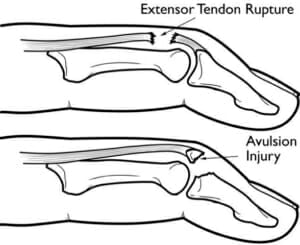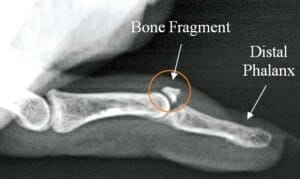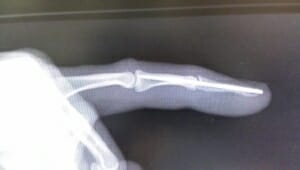Mallet Finger (Baseball Finger)
Patient Education

Fig. 1 – Mallet finger injury with drooping of tip.
Overview
Mallet finger is an injury to the thin tendon that straightens the end joint of a finger or thumb. This injury is also known as “baseball finger.” In which, an injury happens when an unyielding object (like a ball) strikes the tip of a finger and forces it to bend beyond its range, causing the tendon to tear. Consequently, the fingertip cannot straighten on its own.

Fig. 2 – Mallet finger injury illustrated with a ruptured extensor tendon.
Causes
Tendons are tissues that connect muscles to bone. The extensor tendons on the top of the hand straighten the fingers; while the flexor tendons on the palm side of the hand bend the fingers. In a mallet injury, the force of an object strikes the tip of the finger or thumb tearing the extensor tendon. However, a minor force such as tucking a bed sheet can occasionally cause a mallet finger injury.
Mallet injury may rupture the tendon or pull the tendon away from the distal phalanx, the bone where tendon is attached. In some cases, a small piece of bone is pulled along with the tendon. This is known as an avulsion injury. Often, the middle, ring and small fingers are more likely to be injured.

Fig. 3 – Illustration of (above) extensor tendon rupture and (bottom) avulsion injury.
Symptoms
Patient will usually notice the finger to be painful, swollen, and bruised. The fingertip will droop noticeably and can only be straighten by pushing it up with the other hand.
Risk for Infection: It is very important to seek immediate attention if there is blood beneath the nail or if the nail is detached. This may be a sign of a cut in the nail bed, or that the finger bone is broken with open fracture, and the wound penetrates down to the bone. These types of injuries put you at risk for infection.
First Aid: To relieve pain and reduce swelling, apply ice to your finger immediately and keep your hand elevated above your heart.
Doctor Examination
A mallet finger injury requires medical treatment to ensure the finger regains as much function as possible. Most doctors recommend seeking treatment within a week of injury. However, some patients were able to achieve full healing even when treatment was delayed for as long as a month after the injury.
Physical Examination
After discussing your medical history and symptoms, your hand specialist will examine your finger or thumb and perform a mallet finger test. During this examination, your doctor will hold the affected finger and ask you to straighten it on your own.

Fig. 4 – X-ray shows that a piece of the distal phalanx bone broke away with the tendon.
X-rays
Your doctor will most likely order x-rays of the injured finger. If a fragment of the distal phalanx was pulled away when the tendon ruptured, or if there is a larger fracture of the bone, it will appear in an x-ray.
Treatment
Untreated mallet finger injuries will typically result in stiffness and deformity of the injured fingertip. The majority of mallet finger injuries can be treated without surgery. Moreover, mallet finger injury in children must be carefully evaluated and treated by a hand specialist to prevent stunting or deformity.
Nonsurgical Treatment
Most mallet finger injuries are treated with splinting. Your hand specialist will apply a splint to hold the fingertip straight (in extension) until it heals.

Fig. 5 – Splints used to treat mallet finger.
To restore function, the splint must be worn full time for 6 weeks. This includes while bathing and sleeping. After bathing, the splint must be changed carefully to keep the injured finger straight, as healing would be disrupted if the fingertip ever droops. In that case, you will need to wear the splint for a longer period of time.
If the tendon heals well after 3 to 4 weeks since the first splint application, your doctor may instruct you to gradually wear the splint less frequently, such as only wearing at night. The goal of splinting treatment is to result in both acceptable function and appearance. However, some patients may not regain full fingertip extension. In some cases when patients have extreme difficulty keeping the splint on, the doctor may decide to insert a temporary pin across the fingertip joint to hold it in extension for 6 weeks.

Fig. 6 – X-ray shows a pin placed across the fingertip joint to keep the tip straight.
Surgical Treatment
When there is a large fracture fragment or the joint is out of line (subluxed), your doctor may consider surgery to repair the fracture and/or the tendon. In these cases, pins are placed to hold the pieces of bone together while the injury heals. On the other hand, the damaged tendon is usually treated with tendon graft or even fusing the joint straight.
A hand surgeon should be consulted in making the decision to treat this condition surgically.
References:
American Society of Surgery of the Hand. (2013). Mallet finger. Retrieved from https://www.assh.org/handcare/condition/mallet-finger#:~:text=A%20mallet%20finger%20is%20a,see%20Figure%201a%20and%201b).
OrthoInfo. (2020). Diseases & conditions: Mallet finger (Baseball finger). Retrieved from https://orthoinfo.aaos.org/en/diseases–conditions/mallet-finger-baseball-finger/


